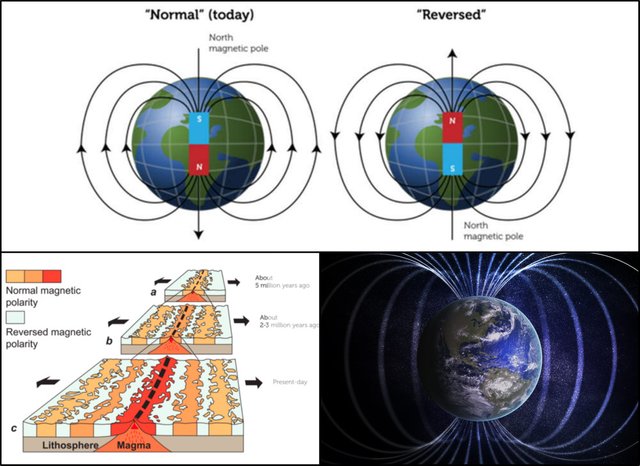
In the penultimate section of Chapter IX of Earth in Upheaval Immanuel Velikovsky investigates the possibility that the polarity of our planet’s magnetic field has undergone reversals within the historical period. In this section he also adduces evidence that the magnetic field at the surface of the Earth was sometimes as much as a hundred times more intense than it currently is, leading him to hypothesize that during global cataclysms powerful extraneous magnetic fields could enhance the Earth’s intrinsic field.
A Brief History
In the 11th century the Chinese scholar Zeng Gongliang, whose predecessors had known about the magnetic compass for over a millennium, discovered that when an iron magnet was heated to red-hot, it lost its magnetic properties. Modern physicists explain this phenomenon by noting that when a magnetic material is heated above its Curie temperature, or Curie point―770 °C in the case of iron―its magnetic moments are knocked out of alignment. When quenched in water, the demagnetized iron is remagnetized by the Earth’s magnetic field―though Zeng did not know how this happened.
The compass appeared in Europe about a century later. It was first described by an English scholar, Alexander Neckam, in the 12th century, and was the subject of several experiments by the French mathematician Petrus Peregrinus in the 13th century.
In 1600 the English physician William Gilbert first suggested that the Earth itself was essentially a giant magnet. Although Gilbert’s De Magnete was highly influential in its day, little progress was made in the field of magnetism until the 19th century.
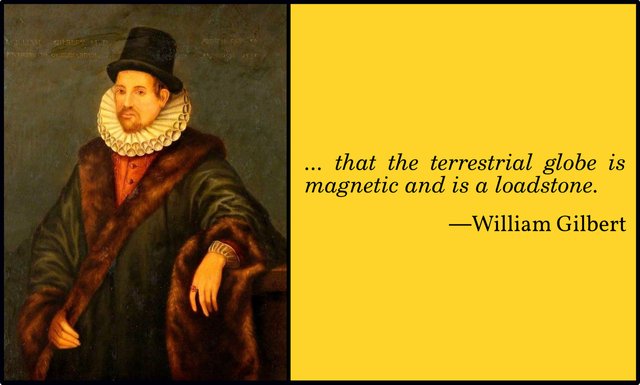
In 1853 the Italian physicist Macedonio Melloni discovered that when lava from Vesuvius cooled and solidified, the resulting rocks were magnetized in the direction of the prevailing geomagnetic field―a phenomenon now known as thermoremanence, or thermoremanent magnetization. In 1894 another Italian geophysicist, Giuseppe Folgheraiter, observed the same phenomenon in Etruscan and Roman pottery. This is essentially the same phenomenon that Zeng Gongliang had observed eight centuries before.
Early in the twentieth century French geophysicist Bernard Brunhes discovered that the Earth’s magnetic field had been of opposite polarity at some time in the past. Brunhes was Director of the Meteorological Observatory of Puy de Dôme, an extinct volcano in France’s Massif Central. In 1905 he was alerted by an engineer to the presence of a deposit of porcellanite beneath a basalt flow in Pontfarein, near Cézens, about 90 km south of Puy de Dôme. Brunhes found that the magnetic inclination preserved in the porcellanite was almost opposite the prevailing inclination―implying that the polarity of the geomagnetic field had undergone at least one reversal after the porcellanite deposits were laid down.
It took almost half a century for the broader scientific community to accept Brunhes’ findings. All doubt was finally removed in the 1950’s when geophysicists discovered that minerals in oceanic rocks deposited on either side of the Mid-Atlantic Ridge were arranged in alternating strips of opposite polarity. This discovery also helped to confirm the theory of Continental Drift.
It was now impossible to deny that the Earth’s magnetic field had undergone numerous reversals at varying intervals of time. The field has alternated between periods of normal polarity, during which the predominant direction of the field is the same as the current direction, and reverse polarity, when the opposite polarity prevails. These periods are called chrons. The last reversal is believed to have occurred 780,000 years ago. Palaeomagnetists refer to the current chron as the Brunhes. The preceding chron began about 2.48 Ma ago and is called the Matuyama. Prior to that was the Gauss Chron, which began 3.6 Ma ago, and the Gilbert Chron, which began 5.3 Ma ago. The reverse polarity discovered by Brunhes at Pontfarein is now believed to date from an even earlier chron about 6.2 Ma ago.
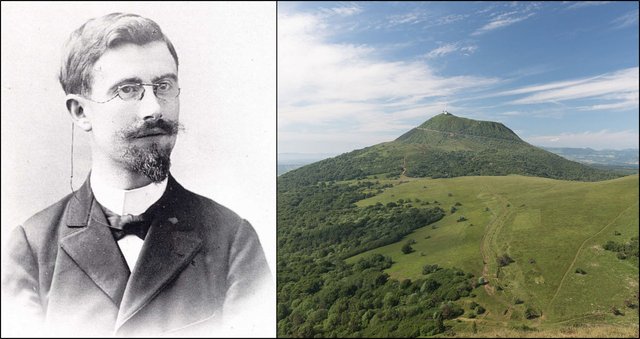
H Manley’s Testimony
Velikovsky begins this chapter with some background information on the subject of thermoremanence. He ends this introduction by noting one anomalous fact about reverse magnetization:
An even more puzzling fact is that the rocks with inverted polarity are much more strongly magnetized than can be accounted for by the earth’s magnetic field. Lava or igneous rock, on cooling below the Curie point, acquires a magnetic charge stronger than the charge this rock would acquire in the same magnetic field at outdoor temperature, but only doubly so. The rocks with inverted polarity, however, are magnetically charged ten times and often up to a hundred times stronger than they could have been by terrestrial magnetism. “This is one of the most astonishing problems of paleomagnetism, and is not yet fully explained, although the facts are well attested.” ―Velikovsky 131
The quotation is taken from a 1949 article by the English metallurgist and physicist H Manley entitled Palæomagnetism―Velikovsky or his editor has Americanized Manley’s British spelling to Paleomagnetism. Manley, then a student of geophysicist John McGarva Bruckshaw at Imperial College London, is mentioned by Velikovsky in the Acknowledgments section of Earth in Upheaval:
Dr. H. Manley of the Imperial College, London, Professor P. L. Mercanton of the University of Lausanne, and Professor E. Thellier of the Observatoire Géophysique of the University of Paris, gave me freely of their knowledge in the field of geomagnetism and sent me reprints of their works. ―Velikovsky vi
As we shall see, P L Mercanton is also cited in this section.

Paleointensity is the study of changes in the strength of the geomagnetic field over the geological history of the planet. I have been unable to confirm whether Manley’s assertion has ever been explained or refuted. Current theory holds that reversals occur when the geomagnetic field is weak:
The Earth’s magnetic field is approximately four times stronger today than it was during the Gauss–Matuyama reversal. ―Wikipedia : Avto Goguitchaichvili et al, An Attempt to Determine the Absolute Geomagnetic Field Intensity in Southwestern Iceland during the Gauss–Matuyama Reversal, Physics of the Earth and Planetary Interiors, Volume 115, Number 1, Pages 53–66 (1999)
After a reversal has taken place, the geomagnetic field recovers its strength.
In 1990 Charles Ginenthal also cited Manley while defending Velikovsky against Carl Sagan’s criticisms:
Sagan argues that if a magnetic storm of such intensity affected the Earth, it would have left a strong signature in the form of remanent magnetism in the rocks. He states, “there is no sign of rock magnetization of terrestrial rocks ever having been subjected to such strong field strengths ...” [SCV, pp. 65–66]. This is incorrect because Velikovsky in his “Forum Address” [Earth in Upheaval 243–271] states of the remanent magnetism found in rocks:
“The newly developed science of paleomagnetism brought, and daily continues to bring, confirmation of the fact that lavas and igneous rocks in all parts of the world are reversely magnetized. But what is more startling is to find that the reversely magnetized rocks are a hundred times [or a thousand times] more strongly magnetized than the earth’s magnetic field could have caused them to be. H. Manley, in his review, writes:
“It may seem strange that a rock which is made magnetic by the earth’s field” should become so strongly magnetized “compared with the generating force. This is one of the most astonishing problems of paleomagnetism.” [Earth in Upheaval 255]
Apparently Sagan when he stated that “there is no sign of rock magnetism of terrestrial rocks ever having been subjected to such strong field strengths” hasn’t any problem with reporting the evidence as compared with H. Manley whose article “Paleomagnetism” [sic] in Science News for July 1949, finds that the rock magnetism of terrestrial rock has been subjected to such strong field strengths. Apparently Manley is unaware that the evidence he reports from his own field cannot be correct because Sagan tells us that it isn’t. One may suspect that Manley, who was astonished by the Earth’s high remanent magnetism would be struck dumb by Sagan’s assertion. But since the rocks do contain high remanent magnetism it had to originate somewhere. ―Ginenthal, Carl Sagan and Immanuel Velikovsky 111
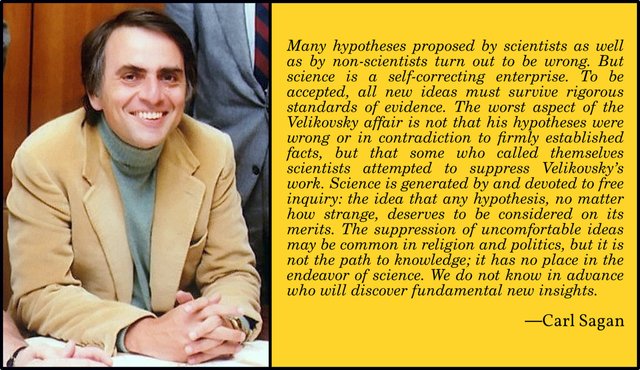
What does Manley actually say about paleointensity?
It may seem strange that a rock that is made magnetic by the earth’s field should become so strong compared with the generating force. This is one of the most astonishing problems of palæomagnetism, and is not yet fully explained, although the facts are well attested. If an igneous rock is cooled through its Curie point in a given field strength, it acquires a magnetisation several times what would be expected from its susceptibility and the intensity of the magnetising field. It is known that most of this colossal intensity is gained just near the Curie point, and that the susceptibility is rarely more than double its room temperature value at the Curie point. The phenomenon is called thermo-remanence, and the residual magnetisation after cooling is almost always more than ten times what one would expect, and quite often up to a hundred times. ―Manley 59
Velikovsky and Ginenthal have accurately reported Manley’s findings.
Velikovsky’s Hypothesis
In the following few paragraphs Velikovsky outlines his own theory to explain these phenomena:
Now, if the earth’s axis changed its direction or position under the influence of an external magnetic field, we should expect to find the following:
The external magnetic field would create eddy (electrical) currents in the surface layers of the earth; the currents would create a magnetic field around the earth that would counteract the external magnetic field. The strength of the magnetic field created by the eddy currents would be dependent on the external magnetic field and the velocity with which the earth traveled through it. The thermal effect of the electrical currents would liquefy the rocks. The process would be accompanied by volcanic activity and intrusion of igneous rock into surface sedimentary rocks. The molten rock would acquire a magnetic state as soon as its temperature dropped to about 580° C [the Curie point for typical rocks]; also, those rocks that were heated below this temperature would acquire the orientation of the prevailing magnetic field. It is also apparent that an external magnetic field that could shift the terrestrial axis in a short time would have to be of considerable intensity.
We have all three expected effects: lava flowed and igneous rock intruded in the form of dykes or otherwise; the heated rocks acquired a reversed magnetic orientation; the intensity of their magnetization is stronger than the earth’s own field could possibly produce. ―Velikovsky 131–132
We now know that periods of reverse polarity lasted hundreds of thousands of years. A reversal of the polarity cannot be attributed to a short-lived catastrophic event that only affected the crust. Short-lived catastrophic events may cause the geomagnetic field to reverse its polarity only if they affect the entire planet, including the core, which is believed to be the seat of the geomagnetic field. Such events could also be invoked to explain the short-lived increase in magnetic intensity mentioned by Manley.
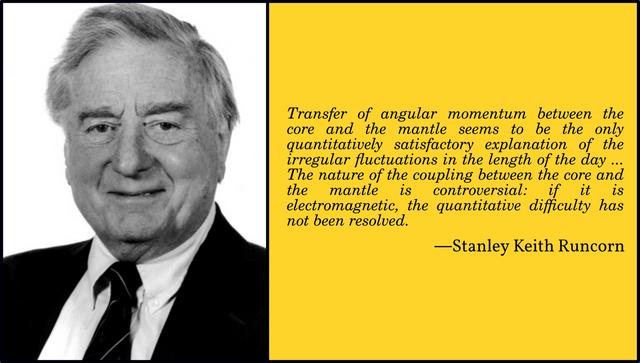
Pole Shift
Can a magnetic field cause a pole shift? That is to say: can the application of a powerful extraneous magnetic field cause the Earth’s axis of rotation to shift? In support of this hypothesis Velikovsky next cites Stanley Keith Runcorn, a physicist at Cambridge University, whose particular field of expertise was paleomagnetism.
If our picture of the generating mechanism is correct we must suppose that the core of the earth is turning within the mantle around it. That is to say, the core is rotating from west to east more slowly than the mantle. There is good astronomical evidence for such a surmise. The speed of the earth’s spin is not constant: very accurate measurements indicate that the time of its daily rotation varies continually by a minute amount. But the law of angular momentum says that if the rotational speed of the earth’s surface changes, there must be an offsetting change of speed somewhere within. Thus if the mantle speeds up, the core must slow down, and vice versa.
The simplest way to account for these changes in speed is to suppose that the core and the mantle exert a force on each other which is produced by electric currents. (The effect would be analogous to that between the rotating armature and the field coils of an electric motor.) Any change in the currents of the core would alter the strength of the force between it and the mantle and affect their relative speeds of rotation. A large, abrupt change would cause a sudden and appreciable acceleration or deceleration of the rotation of the earth’s surface. As a matter of fact, in 1897 its rotation suddenly speeded up by nearly three thousandths of a second per day, and in 1914 it decreased by about the same amount.
Now the simple model we have considered would leave unexplained some important aspects of the earth’s magnetic field. To begin with, why should the currents flow around the axis of the core in one direction rather than the other, so that the magnetic field is oriented north-south? Secondly, there is the difficulty of the reversal of the magnetic poles. If this model were correct, we would have to suppose that from time to time in geologic history the currents died out and then started in the opposite direction ...
Whatever the mechanism, there seems no doubt that the earth’s magnetic field is tied up in some way with the rotation of the planet. And this leads to a remarkable finding about the earth’s rotation itself. Aside from the complete reversals, or flip-flops, of the magnetic field, the magnetic poles have wandered gradually throughout the period of magnetic history readable in the rocks. We can only suppose from this that the earth’s axis of rotation has changed also. In other words, the planet has rolled about, changing the location of its geographic poles ... Either mountain building or convection currents in the mantle might account for this rolling. If the hypothesis of the wandering poles is verified, naturally it will be of great importance to geologists. It may explain, for example, the known fact that in the remote geological past there were glaciers near the present equator. ―Runcorn 160 ... 162
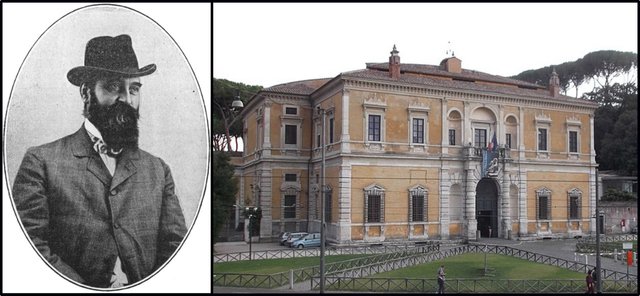
Recent Magnetic Reversals
Today it is conventionally claimed that the most recent magnetic reversal occurred about 780,000 years ago, at the beginning of the Brunhes Chron, but Velikovsky adduces evidence that contradicts this view:
Most interesting is the discovery that the last time the reversal of the magnetic field took place was in the eighth century before the present era, or twenty-seven centuries ago. The observation was made on clay fired in kilns by the Etruscans and Greeks.
The position of the ancient vases during firing is known. They were fired in a standing position, as the flow of the glaze testifies. The magnetic inclination or the magnetic dip of the iron particles in the fired clay indicates which was the nearest magnetic pole, the south or the north.
In 1896 Giuseppe Folgheraiter began his careful studies of Attic (Greek) and Etruscan vases of various centuries, starting with the eighth century before the present era. His conclusion was that in the eighth century the earth’s magnetic field was inverted in Italy and Greece. Italy and Greece were closer to the south than to the north magnetic pole. ―Velikovsky 132–133
The sources cited for this information are two articles by Folgheraiter and one by the Swiss glaciologist Paul Louis Mercanton―though Velikovsky’s immediate source was Manley’s article. Velikovsky cites the first of these as Rendi Conti dei Licei instead of Rendiconti della Reale Accademia dei Lincei (Proceedings of the Royal Lincean Academy), which published Folgheraiter’s article in 1896. A French account of Folgheraiter’s researches was published in Geneva in 1899, from which the following translation is taken:
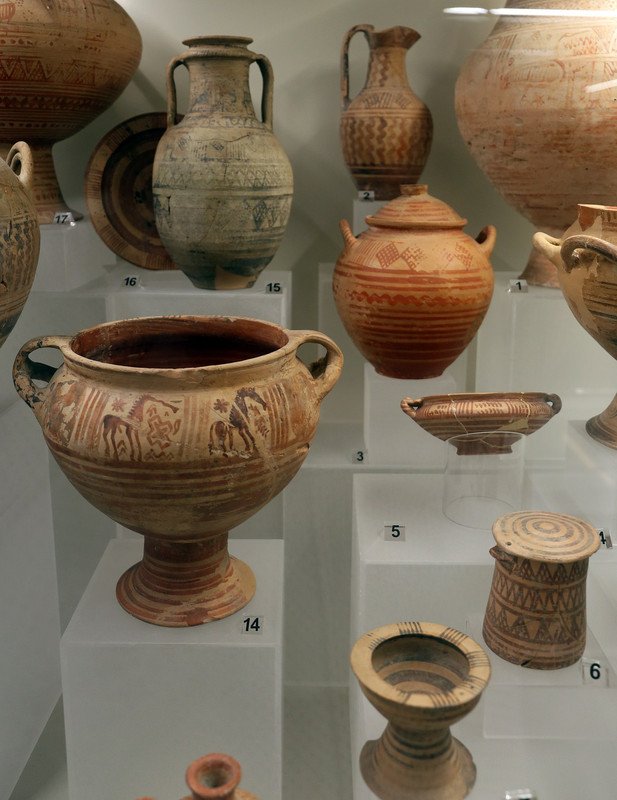
My examination of the Etruscan vases that are held by the Villa Giulia Museum in Rome and those in the rich private collection of Count Faina in Orvieto has led to the following results:
In the eighth century BC the magnetic inclination in central Italy had a very small value and, moreover, it was southern (that is to say, the lowest extremity of a magnetic needle would have been not the north pole, as at present, but the south pole); two centuries later the value of the inclination was essentially zero. ―Folgheraiter 1899:14
This is an extraordinary result, and flies in the face of current orthodoxy. According to Folgheraiter normal polarity had become established by the 5th century BCE:
My examination of Attic and Corinthian vases preserved in the Museums of Florence, Naples and Syracuse has led to the following results:
In the period of the first Corinthian vases and Attic black figures on a red background the inclination was southern [reverse] (7th century BC).
Shortly after this, perhaps at the beginning of the 6th century, the inclination was zero and later became northern [normal]. Near the end of the Attic vase-making period (end of the 5th century BC) the inclination was almost 20° and northern, the same value as the current one. ―Folgheraiter 1899:14
Folgheraiter, therefore, believed that a magnetic reversal took place between 700 and 400 BCE. Did a magnetic reversal actually take place as recently as two or three millennia ago?
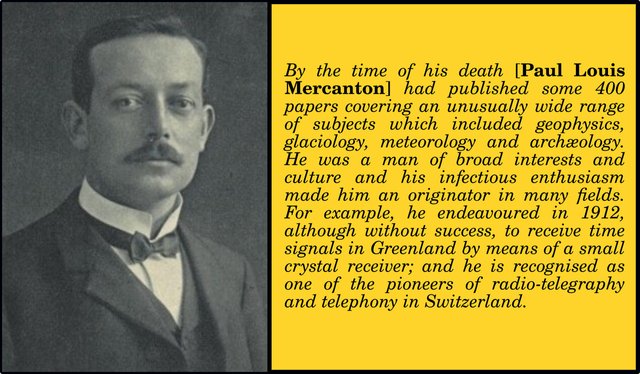
Mercanton’s Research
The Swiss glaciologist Paul Louis Mercanton also carried out research in this field. He was primarily motivated by a desire to verify Folgheraiter’s surprising results. The work cited by Velikovsky is a French article, which was published in Geneva in 1907 in the Archives des sciences physiques et naturelles: La méthode de Folgheraiter et son rôle en géophysique [Folgheraiter’s Method and His Role in Geophysics]. Velikovsky does not quote from this article, but claims that Mercanton vindicated Folgheraiter:
P. L. Mercanton of Geneva, studying the pots of the Hallstatt age from Bavaria (about the year –1000) and from the Bronze Age caves in the neighborhood of Lake Neuchatel, came to the conclusion that about the tenth century before the present era the direction of the magnetic field differed only a little from its direction today, and yet his material was of an earlier date than the Greek and Etruscan vases examined by Folgheraiter. But checking on the method and the results of Folgheraiter, Mercanton found them perfect. ―Velikovsky 133
Velikovsky seems to be suggesting that the period of reverse polarity only lasted a few centuries, interrupting the normal polarity of the second millennium BCE. But is this what Mercanton’s paper actually implies?
M. Mercanton then subjected Folgheraiter’s method to the test, following the same procedure as the Italian scholar, firstly (1902) on pile-dwelling vases preserved at the Lausanne Museum, then (1905) on vases from the Hallstatt period, held by the Archaeological Museum in Munich ...
Criticism of his observations led Mr. Mercanton to conclude that at the time known as the “bel âge du Bronze” [Late Bronze Age] (around 1500 BC) the earth’s magnetic inclination was, at the lacustrine station of Corcelettes (Lake Neuchâtel), northern [normal], and rather strong. ―Mercanton 470 ... 471
The information taken from Bavarian vases is therefore in clear contradiction with that provided by Etruscan ceramics, unless we admit, which seems difficult, that over a distance of some 500 kilometres, the direction and sense of the earth’s magnetic inclination can experience such enormous variations. On the other hand, the concordance of the two periods of manufacture seems indisputable.
Mr. Folgheraiter has sufficiently established the legitimacy of the use of his method in the case of Etruscan ceramics, so that doubt in this regard is not permitted. It therefore remains to consider the following two alternatives: either the Hallstatt vases were fired upside down, resting on their mouths, despite their protruding handle, or else the clay from which they are made does not offer sufficient magnetic stability. ―Mercanton 471–472
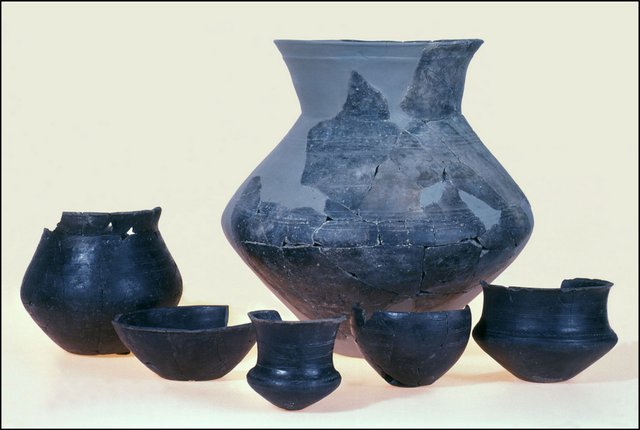
Mercanton, therefore, was satisfied that the method employed by Folgheraiter was scientifically valid, but the results he got when he applied this method to material roughly contemporaneous with Folgheraiter’s Etruscan vases did not corroborate Folgheraiter’s findings.
But were they contemporaneous? The Bronze Age phase of the Hallstatt Culture (Hallstatt A and B) is currently dated to 1200–800 BCE, whereas Folgheraiter dated his Etruscan vases to the 8th century: 800–700 BCE. It is reprehensible that Velikovsky does not present this part of the story to his readers, but in his defence he could argue that the reverse polarity only prevailed during a global catastrophe that occurred in the 8th century. When the catastrophe was over, the Earth’s native geomagnetic field reasserted itself.
H Manley does note the discrepancy between Folgheraiter and Mercanton’s findings, and the difference in age:
P. L. Mercanton , of Geneva, studied pots of the Hallstatt age from Bavaria and of the Bronze age from caves beside Lake Neuchâtel. His results did not agree well with Folgheraiter’s, since they give a direction of magnetisation only a little different from that found to-day and yet were earlier than Folgheraiter’s. ―Manley 46–47
He later summarizes the results of his own research in this field:
It would seem, then, that the earth’s magnetic field was reversed about 350–500 million years ago, again at about 200 and again about 10 to 30 million years. After the 10 million epoch it was probably ‛normal’, as now, with the possibility of its reversal in historical times, 2500 years ago, to be cleared up by more research. ―Manley 57
To be fair, Velikovsky does quote the concluding clause of Manley’s remark in a footnote, adding his own comment:
Manley speaks of “the possibility of its [earth’s magnetic field] reversal in historical times, 2500 years ago, to be cleared up by more research.” However, the more exact date is, according to the original works of Folgheraiter and Mercanton, the eighth century before the present era, or shortly thereafter. ―Velikovsky 134 fn 9
Has more research demonstrated that no reversal of the geomagnetic polarity took place in historical times? The conventional view is that such reversals only occur every 700,000 or so years, but I have been unable to find any paper or study that settles the matter once and for all and explicitly refutes Folgheraiter’s findings. Folgheraiter and Mercanton’s studies are often cited on account of their historical significance in the field of paleomagnetism, but no one seems to be interested in resolving the dispute between them.
If the Earth suffered a global cataclysm in the 8th century BCE, as Velikovsky believes, the surface of the Earth may have been subjected to an extraneous magnetic field powerful enough to dominate over the Earth’s own geomagnetic field for a short period of time―at least on a local if not a global scale. Perhaps it was during such a period of time that Folgheraiter’s Etruscan vases were fired. Geophysicists now know that the Earth’s magnetic field experiences global and local anomalies on an irregular basis. These geomagnetic jerks are characterized by relatively sudden changes in the rate at which the magnetic field varies. Their cause is still a matter of scholarly debate. One particularly large jerk took place in the Middle East during the Iron Age. The Levantine Iron Age Anomaly is dated to 1050–700 BCE. Although evidence of this anomaly was first discovered in Mesopotamia, it is now known that its effects reached from Iberia to Turkmenistan (Caricchi et al 7). Could this be what Folgheraiter was detecting, rather than a full-blown magnetic reversal?
François-Alphonse Forel
Velikovsky cites one other Swiss scholar before closing this section. Swiss limnologist and glaciologist François-Alphonse Forel was Mercanton’s mentor. Shortly before his death in 1912 he helped to set up an expedition to Greenland in which Mercanton played an important role:
An ancient vase found by F. A. Forel in Boiron de Morges, on Lake Geneva, was broken and its pieces were scattered and lay in all directions; when assembled, they all showed one and the same magnetic orientation, which proves again that the magnetic field of the earth was unable to change the orientation originally acquired by the clay when fired and cooled in the kiln. ―Velikovsky 133
The citation is to a report of the sitting of the Société vaudoise des sciences naturelles on 15 December 1909:
Mr. Paul-L. Mercanton took advantage of a ceramic find made by Mr. F.-A. Forel, in a burial at Boiron de Morges, to check, in the case of lake pottery, the value of the fundamental hypothesis of Folgheraiter’s method. This method makes it possible to deduce from the magnetometric examination of a terracotta vase, the terrestrial magnetic inclination at the place and time of its firing. The hypothesis which serves as its basis is that the magnetization acquired by the object at the time of firing has not varied over the ages. It has been verified in all the cases studied so far; but verification had not been attempted for lake ceramics due to lack of adequate equipment. The Boiron find provided this material in the form of a well-fired and homogeneous earthenware vase, found broken into small pieces. The operational process is in fact this: we collect the fragments, we submit them to magnetometric examination, then we reconstitute the vase piece by piece and we study its general magnetic distribution. If the pieces have retained the magnetization they had before the breakage of the vase, their juxtaposition restores the initial magnetic distribution. Otherwise this distribution appears disordered.
Likewise, the shards must find in the reconstruction of the object the locations that their magnetic examination previously assigns to them.
The sherds of the Boiron vase presented a very clear magnetic distribution characteristic of each of them. Reconstructed by the skillful care of Mr. Tauxe, assistant at the Archaeological Museum, this vase, although incomplete, showed great regularity of magnetization. The mouth was clearly south, the bottom north; this is what the author has recognized so far for most vases from the Bronze Age, to which this one belongs. The magnetic inclination was strongly northern [ie normal] at this time in our regions.
The object studied presents all the ceramic characteristics of vases from its time. Nothing leads us to think that he behaves to the point of magnetic sight, unlike its peers.
The result of the examination therefore constitutes a strong presumption in favor of the magnetic rigidity of pile-dwelling ceramics. This permanence of the magnetization must even be very great, since, despite the importance of the demagnetizing factor for the thin magnetic plates, the magnetization of the fragments, normal to the wall, was considerable in most of them.
If other research of the same type confirms this result, we will be able to apply the Folgheraiter method to a number of earthen objects cooked, considered until now to be too fragmentary to be usable.
M F.-A. Forel adds a few words on the probable age of the vase presented by Mercanton. Found in a cremation grave in the Boiron cemetery near Morges, although remarkable for the fineness of the clay, the thinness of the walls and the perfection of the firing which gave it a beautiful red color, this vase presents a certain decorative character, among other things a crown of rosettes with concentric circles, which must attribute it to the beautiful bronze age of the pile-dwellers, like the rest of the vases collected in this cemetery. Vase No. 143, tomb XXV, was crushed and reduced to pieces by the thrust of the earth; 92 pieces were collected, some of them small.―Forel XIV–XV
In Conclusion
After his usual habit, Velikovsky concludes by summing up the main thrust of this section of Earth in Upheaval:
These researches, continued and described in a series of papers by Professor Mercanton, presently with the Service Météorologique Universitaire in Lausanne, show that the magnetic field of the earth, not very different from what it is today, was disturbed sometime during or immediately following the eighth century to the extent of complete reversal.
The eighth and the beginning of the seventh centuries before the present era were periods of great cosmic upheavals, described in Worlds in Collision, pages 207–359 [Part II, Chapters 1–9]. At one of the occurrences the solar motion appeared to be reversed, reflecting some disturbance in the terrestrial motion. ―Velikovsky 133–134
And that’s a good place to stop.
References
- C Caricchi et al, A Refined Age-Calibrated Paleosecular Variation and Relative Paleointensity Stack for the NW Barents Sea: Implication for Geomagnetic Field Behavior during the Holocene, Quaternary Science Reviews, Volume 229, Article 106133, Elsevier, Amsterdam (2020)
- Giuseppe Folgheraiter, Ricerche sull’inclinazione magnetica all’epoca etrusca, Rendiconti della Reale Accademia dei Lincei, Serie V, Volume V, Semester 2, Pages 293–300, Classe di Scienze Morale, Storiche e Filologiche, Tipografia della Accademia, Rome (1896)
- Giuseppe Folgheraiter, Ricerche sull’inclinazione magnetica col mezzo della distribuzione del magnetismo libero nei vasi fittili antichi, Rendiconti della Reale Accademia dei Lincei, Serie V, Volume VIII, Semester 1, Pages 69–76, Classe di Scienze Morale, Storiche e Filologiche, Tipografia della Accademia, Rome (1899)
- Giuseppe Folgheraiter, Ricerche sull’inclinazione magnetica nel I secolo a. Cr. e nel I secolo dell’Era volgare, calcolata da vasi fittili di Arezzo e Pompei, Rendiconti della Reale Accademia dei Lincei, Serie V, Volume VIII, Semester 1, Pages 121–129, Classe di Scienze Morale, Storiche e Filologiche, Tipografia della Accademia, Rome (1899)
- Giuseppe Folgheraiter, Ricerche sull’inclinazione magnetica durante il periodo di fabbricazione dei vasi fittili greci, Rendiconti della Reale Accademia dei Lincei, Serie V, Volume VIII, Semester 1, Pages 176–183, Classe di Scienze Morale, Storiche e Filologiche, Tipografia della Accademia, Rome (1899)
- Giuseppe Folgheraiter, Ricerche sull’inclinazione magnetica durante il periodo di fabbricazione dei vasi fittili greci, Rendiconti della Reale Accademia dei Lincei, Serie V, Volume VIII, Semester 1, Pages 269–275, Classe di Scienze Morale, Storiche e Filologiche, Tipografia della Accademia, Rome (1899)
- Giuseppe Folgheraiter, Sur les variations séculaires de l’inclinaison magnétique dans l’antiquité, Archives des sciences physiques et naturelles, 104th Year, 4th Period, Volume 8, Pages 5–16, Bureau des Archives, Geneva (1899)
- Giuseppe Folgheraiter, Sur les variations séculaires de l’inclinaison magnétique dans l’antiquité, Journal de physique théorique et appliquée, Volume 8, Number 1, Pages 660–667, Société Française de Physique, Paris (1899)
- F A Forel, Communications scientifiques, Bulletin de la Société vaudoise des sciences naturelles, Volume 46, Assemblée Générale, Mercredi 15 Décembre 1909, Pages XIV–XV, Frédéric Jaccard, Lausanne (1910)
- William Gilbert, On the Loadstone and Magnetic Bodies and on the Great Magnet the Earth, A Translation by P Fleury Mottelay, John Wiley & Sons, New York (1893)
- H Manley, Palæomagnetism, Science News, Number 12, Pages 43–64, Penguin Books, London (1949)
- Paul Louis Mercanton, La méthode de Folgheraiter et son rôle en géophysique, Archives des sciences physiques et naturelles, 112th Year, 4th Period, Volume 23, Pages 467–482, Bureau des Archives, Geneva (1907)
- Stanley Keith Runcorn, The Earth’s Magnetism, Scientific American, Volume 193, Issue 3, Pages 152–154 : 157–158 : 160 : 162, Scientific American, New York (1955)
- Immanuel Velikovsky, Earth in Upheaval, Pocket Books, Simon & Schuster, New York (1955, 1977)
Image Credits
- Magnetic Reversal: © Solarstorms, Fair Use
- Magnetic Anomalies: Chmee2 (designer), United States Geological Survey, Public Domain
- Geomagnetic Field: Shutterstock, vchal (creator), Fair Use
- William Gilbert: Anonymous Portrait, Wellcome Institute for the History of Medicine, London, Public Domain
- Bernard Brunhes: Anonymous Photograph, Comptes rendus de l’Académie des Sciences, Series 2, Volume 328, Number 2_, Public Domain
- Puy de Dôme: © William Crochot (photographer), Creative Commons License
- Imperial College London: Royal College of Science and Technology, South Kensington, London (1957), © Imperial College London, Creative Commons License
- Carl Sagan: NASA/JPL, Public Domain
- Stanley Keith Runcorn: © American Geophysical Union, AIP Emilio Segre Visual Archives, Fair Use
- Giuseppe Folgheraiter: Anonymous Photograph, Emilio Oddone (1914), Public Domain
- Villa Giulia, Rome: © Sergio d’Afflitto (photographer), Creative Commons License
- Etruscan Pottery in the Villa Giulia Museum: © Sailko (photographer), Creative Commons License
- Paul Louis Mercanton: Léon François-Francis de Jongh (photographer), Public Domain
- Bronze Age Pottery from Grandson-Corcelettes Les Violes, Switzerland: © Daniel Fibbi-Aeppli (photographer), Musée cantonal d’archéologie et d’histoire, Lausanne, Fair Use
